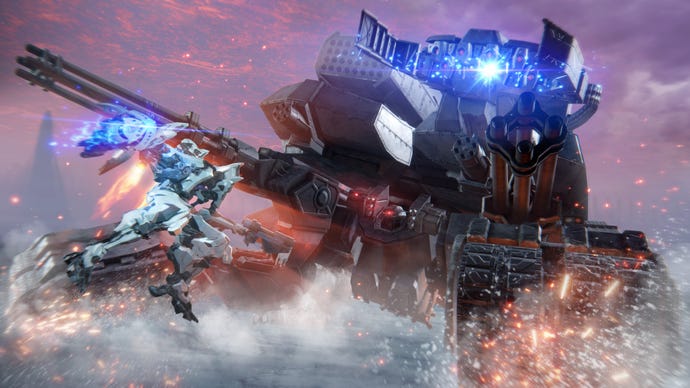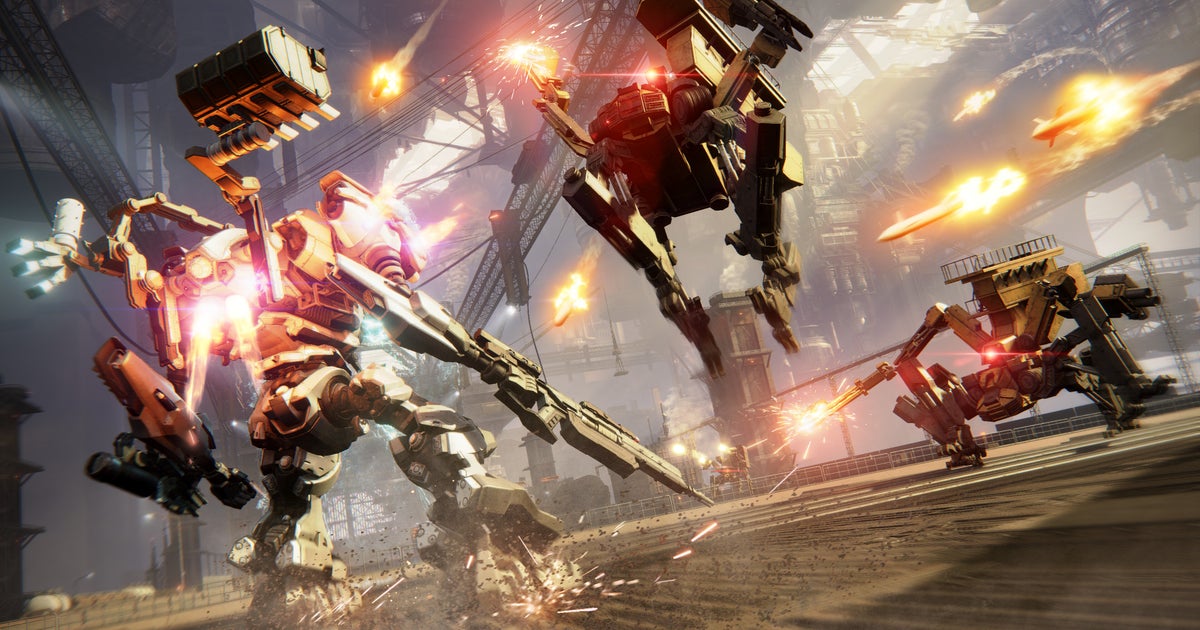With a trusty can of Red Bull coursing through my veins and my heart rate pounding like a jackhammer, I spent around three hours with Armored Core 6: Fires Of Rubicon’s first chapter. And rather like Red Bull’s metallic fizz of aspartame and rocket fuel, I’d say the game shares a similar makeup. It doesn’t give you wings, but what it does give you is a mech as nimble as a Eurasian Blue Tit darting at a confetti of stale bread.
As a historic mech-disliker, the game actually managed to instil a desire to become a skilled mech pilot. I want to buy new metal legs and attach gatling guns to my spine! But I’m apprehensive about the grind to get those parts and whether some of AC6’s Souls influences clash with its rapid pace.
It might be obvious to long-time Armored Core-likers, but if you’re someone who’s become a fan of FromSoftware thanks to Elden Ring and have since discovered their tremendous back catalogue of Souls corkers, consider this a warning: Armored Core 6 is not a Souls game. Yes, there are obvious influences, but it’s no tentative unpicking of a vast map with pit stops at warm bonfires to rest your legs. It seems colder at heart, where success lies in motoring through missions to pop the best new metal bits on your robot; Souls is an adventure, Armored Core 6 is a chase.
Contrary to popular belief, the game’s story doesn’t revolve around corporations fighting over a terrifically hot can of Rubicon. They’re actually fighting over a mysterious substance that’ll grant them lots of power to alter humanity, yada yada yada. You play as a mercenary who seemingly bounces between corporations and does their bidding. In 100% of cases, a handler named Walter will ask you to destroy a hunk of metal and then bid you adieu. To be frank with you, I couldn’t give a monkeys about the story because – at least early on – it struck me as faceless. It’s all just logos with voices giving you boring orders over a radio and your character wordlessly agreeing with it all.
“I’m Yuzuru Hanyu, an Olympic gold medallist with a missile launcher hooked over my shoulders and an engine for an elbow”
Things kick off in the garage, a hub menu which you’ll leave and return to after every mission. It’s here where you’re able to buy and sell parts for you mech, give it a jazzy colour scheme, and tinker with its construction. While it’s a bit too early to tell, I sense the rhythm of the game lies in replaying missions to help fund mechs powerful enough to overcome whatever hunk of metal stands in your way. Where in Elden Ring you might cut through some forgotten fog of war to power up, your only choice in Armored Core 6 is to revisit old battlegrounds and rinse them for bills.
The levels I sampled were a mixture of icy arenas, iron holds, and sand-blasted wastes. Most of the levels I encountered did enough to keep the bounce between objectives interesting, although I wouldn’t say many of them facilitated complex strategies or put me in uncomfortable scenarios I’d need to approach differently. One sandy level in particular was spectacular, though, almost as if most missions are purposely forgettable with a few clearly penned as set pieces. I had to clamber upon an AT&T of mammoth proportions, craning the camera upwards to search for little ledges on its legs I could boost upwards to, as its joints folded and extended. A huge eye at its center kept firing off these lasers, so I needed to carefully maneuver around its body, destroy its little sentry defenses, and explode its pressure points to bring it to its knees. Easily, easily, the best mission I played, and a much-needed reminder that Armored Core 6 is clearly capable of pushing past basic arena bounds.
What’s odd about Armored Core’s rhythm, though, is its sudden peaks in difficulty. For most of the first chapter I breezed through levels. This isn’t a humblebrag, I just genuinely felt zero threat from most bad robos, to the point where I’d downgrade their status to glorified toasters in moments. So long as I boosted around and held down the shoot button, I’d win in the end. Aside from the odd moment where cannons or snipers were stationed at lookouts, I just hammered between objectives like, “Destroy the canisters”, or “Eliminate the doodads” and received zero repercussions for racing through the finish line. Not that breather missions are a bad thing, I was just a bit thrown off by the speed at which I could complete a level having been humbled by FromSoft over the years. As per, I bet these easier levels become a lot tougher later on. I fully expect those little toasters to be upgraded to gas ovens who’ll suck me into their burning cores, then just fully roast me at 200 degrees for 20-minutes.
But just as I got comfortable, a boss called the Juggernaut showed up. A towering sentinel a bit like Shunt the house robot from Robot Wars: a giant trowel face, acting as an impenetrable shield to a weak backside composed of engines and transistors. For what felt like an eternity, I butted my head against this slab of metal. I swapped out parts on the reg. I went aggressive, hoping to fly over it and batter it with my energy sword when it stopped for a breather. I went defensive, hoping to find small openings as a reward for my patience. I felt like I tried everything and what troubles me is I never arrived at a solution.

In any Souls or Soulslike, I’ve always been able to identify the little blip in a boss where they’re vulnerable, or at least a way to prize open a weakness where there is none. The juggernaut is an anomaly, both a blow to my ego and one that also exploses a chink in the game’s earliest moments. Namely, you can’t buy or sell parts unless you quit a mission and restart it from scratch. Yes, you can swap out parts you already own, but what if those aren’t working out for you? I understand that when you leave the garage, you’re essentially signing away your right to trade and that’s something players will have to accept. What this implies, though, is the need to revisit missions to get money and buy parts suited to your opponent. The trouble here lies in the fact that those who’ve built their bots differently up to a certain point are then exposed to, perhaps, the most colossal of ballaches: a grind to undo every past decision.
“But but but” bounces around my head whenever I think of my gripes with the game’s earliest big boss and the surrounding faff. I come back to how brilliant it feels to pilot a mech, and how it makes me feel like the majestic Eurasian Blue Tit as I boost through the sky and twist and turn. One button lets me thrust forwards with force, and with a quick flick of the stick I can dart left and right to avoid getting my wings clipped. On the ground, I transform from a common garden bird to a ten-tonne figure skater. I’m able to pirouette around bots in a way that makes them look like amateurs down the ice rink and me? I’m Yuzuru Hanyu, an Olympic gold medallist with a missile launcher hooked over my shoulders and an engine for an elbow.

Perhaps the game’s biggest triumph is how it’s taught me mechs don’t have to be clunky tanks who strafe to and fro, reloading shells at a snail pace. With up to two shoulder-mounted weapons and two in your fists, combat winds up being a fast dance where you’re unloading shrapnel as soon as those cooldowns refresh, giving it a slight MMO/ARPG energy. Despite my hatred for the Juggernaut, I’d say fights are genuinely exhilarating when you go up against other mercenaries who’ve got sizeable mechs and surprising limbs. It’s during these tangos where the stagger bar comes into play, as you need to find openings to pepper them so it fills up, then swoop in for a hammer blow when they’re vulnerable. I’m determined to crack the Juggernaut puzzle.
I’ve come away from Armored Core 6’s earliest hours with mixed feelings. Combat is a genuine thrill, especially so when you come up against mechs that aren’t toasters but mercenaries who’ll actually fight back. The chase for new parts is certainly moreish, but I doubt revisiting old levels to grind for cash will be for everyone, especially when some are far more basic affairs than others. And I can’t offer much on mech customisation aside from the fact it seemed fun, if a bit unclear? Maybe as you progress there’s plenty more bits to buy and a greater sense of actual change in the moment. With all this said, I imagine longtime fans will be smitten with its slick re-emergence and I, for one, will be keeping a close eye on it. I mean, it’s the only mech game I’ve ever enjoyed, so that must count for something.


